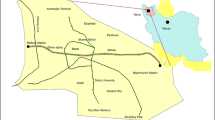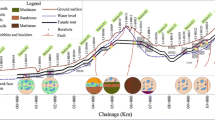Abstract
An accurate determination of the ground condition ahead of a tunnel face is key to stable excavation of tunnels using a Tunnel Boring Machine (TBM). This study verifies the effectiveness of using the Induced Polarization (IP) method along with electrical resistivity for identifying hazardous ground conditions ahead of a tunnel face. The advancement of the TBM toward a fault zone, seawater bearing zone, soil-to-rock transition zone, and mixed-ground zone is artificially modeled in laboratory-scale experiments. The IP and resistivity are assumed to be measured at the tunnel face, whenever the excavation is stopped to assemble one ring of a segmental lining. The measured IP showed completely different trends from the measured resistivity and varies with the type of hazardous zone. As the TBM approached the fault zone, transition zone, and mixed ground, the IP values were observed to be constant, increasing, and fluctuating, respectively. Therefore, a more reliable prediction of the ground condition ahead of a tunnel face can be achieved by using the IP and resistivity methods together. A table that can be used to predict the ground conditions based on the afore-mentioned methods is presented in this paper for use in mechanized tunneling job sites.
Similar content being viewed by others
References
Archie, G. E. (1942). “The electrical resistivity log as an aid in determining some reservoir characteristics.” Trans. Am. Inst. Min. Metall. Eng., Society of Petroleum Engineers, Vol. 146, No. 1, pp. 54–62, DOI: 10.2118/942054-G.
Chang, S. H., Bae, G. J., Jeon, S., Yu, Y. I., and Oh, S. J. (2006). “Risk management in a TBM Tunnel.” 13th Tunnel Committee Special Conference, KSCE, Seoul, Korea, pp. 91–114 (in Korean).
Cho, G. C., Choi, J. S., Lee, G. H., and Lee, J. K. (2005). “Prediction of ground-condition ahead of tunnel face using electric resistivityanalytical study.” Proc. of Int. World Tunnel Cong., AITES-ITA, Istanbul, Turkey, pp. 1187–1194.
Choi, S., Kim, H. S., and Kim, J. S. (2008). “IP characteristics of sand and silt for investigating the alluvium aquifer.” J. Engng. Geol., Vol. 18, No. 4, pp. 423–431 (in Korean).
Dickmann, T. and Sander, B. K. (1996). “Drivage-concurrent Tunnel Seismic Prediction (TSP): Results from Vereina north tunnel megaproject and Piora pilot gallery.” Geomechanik-Kolloquium, Vol. 14, No. 6, pp. 406–411.
Grodner, M. (2001). “Delineation of rockburst fractures with ground penetrating radar in the Witwatersrand basin, South Africa.” Int. J. Rock Mech. Min. Sci., Vol. 38, No. 6, pp. 885–891, DOI: 10.1016/S1365-1609(01)00054-5
Hamdia, K. M., Lahmer, T., Nguyen-Thoi, T. and Rabczuk, T. (2015). “Predicting the fracture toughness of PNCs: A stochastic approach based on ANN and ANFIS.” Computational Materials Science, Vol. 102, pp. 304–313, DOI: 10.1016/j.commatsci.2015.02.045
James, A. and Richard, P. (2011). “Inexpensive geophysical instruments supporting groundwater exploration in developing nations.” J. Water Resour. Prot., Vol. 3, No. 10, pp. 768–780, DOI: 10.4236/jwarp.2011.310087.
Kaus, A. and Boening, W. (2008). “BEAM-geoelectrical ahead monitoring for TBM-drives.” Geomech. Tunn., Vol. 1, No. 5, pp. 442–449, DOI: 10.1002/geot.200800048.
McDowell, P. W., Barker, R. D., Butcher, A. P., Culshaw, M. G., Jackson, P. D., McCann, D. M., Skipp, B. O., Matthews, S. L., and Arthur, J. C. R. (2002). Geophysics in engineering investigations, CIRIA, London, UK, pp. 61–185.
Morrow, C., Lockner, D. A., and Hickman, S. (2015). “Low resistivity and permeability in actively deforming shear zones on the San Andreas Fault at SAFOD.” J. of Geoph. Resear., Vol. 120, No. 12, pp. 8240–8258, DOI: 10.1002/2015JB012214.
Park, J., Lee, K. H., Kim, B. K., Choi, H., and Lee, I. M. (2017a). “Predicting anomalous zone ahead of tunnel face utilizing electrical resistivity: II. Field tests.” Tunn. Undergr. Space Technol., Vol. 68, pp. 1–10, DOI: 10.1016/j.tust.2017.05.017.
Park, J., Lee, K. H., Park, J., Choi, H., and Lee, I. M. (2016). “Predicting anomalous zone ahead of tunnel face utilizing electrical resistivity: I. Algorithm and measuring system development.” Tunn. Undergr. Space Technol., Vol. 60, pp. 141–150, DOI: 10.1016/j.tust.2016.08.007.
Park, J., Lee, K. H., Seo, H., Ryu, J., and Lee, I. M. (2017b). “Role of induced electrical polarization to identify soft ground/fractured rock conditions.” J. Appl. Geoph., Vol. 137, pp. 63–72, DOI: 10.1016/j.jappgeo.2016.12.017.
Reynolds, J. M. (1997). An introduction to applied and environmental geophysics, John Wiley & Sons, New York, N. Y., pp. 289–348.
Robert, A. (2014). Forward probing ahead of tunnel boring machines, AFTES recommendations GT24R2A1, French Tunnelling and Underground Space Association, Paris, pp. 132–169.
Schaeffer, K. and Mooney, M. A. (2016). “Examining the influence of TBM-ground interaction on electrical resistivity imaging ahead of the TBM.” Tunn. Undergr. Space Technol., Vol. 58, pp. 82–98, DOI: 10.1016/j.tust.2016.04.003.
Telford, W. M., Geldart, L. P., and Sheriff, R. E. (1990). Applied geophysics, second ed., Cambridge University Press, New York, N. Y., pp. 578–609.
Titov, K., Kemna, A., Tarasov, A., and Vereecken, H. (2004). “Induced polarization of unsaturated sands determined through time domain measurements.” Vadose Zone Journal, Vol. 3, No. 4, pp. 1160–1168, DOI: 10.2113/3.4.1160.
Toth, A., Gong, Q., and Zhao, J. (2013). “Case studies of TBM tunnelling performance in rock-soil interface mixed ground.” Tunn. Undergr. Space Technol., Vol. 38, pp. 140–150, DOI: 10.1016/j.tust.2013.06.001.
Van Nostrand, R. G. and Cook, K. L. (1966). Interpretation of resistivity data, U.S. Government Printing Office, Alexandria, Washington, USA, pp. 45–55.
Vlasov, S. N., Makovsky, L. V., and Merkin, V. E. (2001). Accidents in transportation and subway tunnels: Construction to operation, Elex-KM Publ. Ltd, Moscow, Russia, pp. 17–87.
Vu-Bac, N., Lahmer, T., Zhuang, X., Nguyen-Thoi, T., and Rabczuk, T. (2016). “A software framework for probabilistic sensitivity analysis for computationally expensive models.” Advances in Engineering Software, Vol. 100, pp. 19–31, DOI: 10.1016/j.advengsoft.2016.06.005.
Author information
Authors and Affiliations
Corresponding author
Rights and permissions
About this article
Cite this article
Park, J., Ryu, J., Choi, H. et al. Risky Ground Prediction ahead of Mechanized Tunnel Face using Electrical Methods: Laboratory Tests. KSCE J Civ Eng 22, 3663–3675 (2018). https://doi.org/10.1007/s12205-018-1357-z
Received:
Revised:
Accepted:
Published:
Issue Date:
DOI: https://doi.org/10.1007/s12205-018-1357-z




